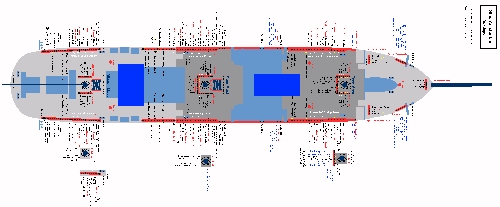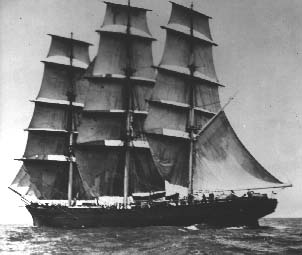Data
| Type/Class:
|
Dimensions:
|
Decks:
|
Armament:
|
Rigging:
|
Crew:
|
| British Clipper Ship
|
Composite hull
Length: 64m
Width: 11m
Height: 46m
|
Flush Deck
poop and forecastle
|
none
|
3 masted full rigger
5-6-5 yards (fore-main-mizzen)
4-3-3 staysails (fore-main-mizzen)
2*3 + 2*3 studding sails (fore-main)
|
20-30
|
History (The First and Second Life of the Cutty Sark)
Designer: Hercules Linton;
Built: Scott, Linton & Co., Dumbarton, Scotland; Year: 1869
Expected life span: 30 years. She survived 140 years!
1870-1878: Races in the Tea Trade with China.
1878: Advent of steamships and Opening of the Suez Canal. Most clippers became "out of business" and were sold cheaply or scrapped.
1880-1895: Races in the Wool Trade with Australia.
1895: Last journey to Australia. Sold to J. A. Ferreira of Lisbon, thus renamed Ferreira.
1899: Sold to the Cia de Navegação de Portugal.
Journeys between Portugal and her empire (Rio, New Orleans, Moçambique, Angola) and the UK.
1914-1918: World War I: many of those old surviving sailing ships were eventually sunk by U boats. Cutty Sark "escaped", journeys in the South Atlantic.
1916: Dismasted in a gale at Cape of Good Hope. Sold. Re-rigged as a barquentine, renamed Maria di Amparo.
1922: Assumed to be lost long ago, she was "rediscovered" in Falmouth by Captain Wilfred Dowman, who eventually bought her to preserve her from scrapping.
Then she was restored for use as a (stationary) full-rigged training ship at Falmouth.
1936: Dowman died. His widow donated the Cutty Sark to the Thames Nautical Training College.
1952: Cutty Sark Preservation Society founded. under the auspices of Frank Carr, director of the National Maritime Museum.
1954: opened as a stationary museum ship at Greenwich. Thus, she remains the only surviving clipper in the world.
1957: opened to the public. Cutty Sark gave her name to the tall-ship races of the International Sail Training Association.
2007: During a major restauration, a fire destroyed her hull. But as many parts were already taken from her, the damage was limited.
She is to be reopened to the public in 2011.
Sources for Research
The Cutty Sark Trust has an archive that can be visited by appointment: http://www.cuttysark.org.uk/
|
Books
| TITLE | AUTHOR | PUBLISHER | YEAR | PAGES |
Clipper Ships & the Cutty Sark
Jackdaw no97 (English) |
Johnson, David |
|
(1975) |
loose |
Cutty Sark
Classic Ships (airfix) (English) |
Hackney, Noel C.L. |
PSL |
1974 |
96 |
Modelling the Cutty Sark
(English) |
Bowness, Edward |
MAP |
1976 |
60 |
Running her Easting Down - The Story of the Cutty Sark and other Great China Clippers
(English) |
Baker, William F. |
The Caxton Printers |
1974 |
170 |
The Cutty Sark - The Last of a Glorious Era
(English) |
Villiers, Alan |
Hodder and Stoughton Ltd. |
1966 |
96 |
The Cutty Sark - The Ship and a model
(English) |
Longridge, Nepean |
Edward W. Sweetman Co, NY |
1959 |
232 |
The Cutty Sark and Thermopylae Era of Sail
(English) |
Hume, Cyril L + Armstrong, MC |
Brown, Son & Ferguson |
1987 |
182 |
The Log of the Cutty Sark
(English) |
Lubbock, Basil |
Brown, Son & Ferguson |
1945/1966 |
332 |
Of course, there are many more ...
Reconstructions
The Rigging
|
The Cutty Sark has a typical full Clipper rigging of the 19th century:
Square yards on all masts, counts: 5-6-5
Staysails on the long bowsprit and between the masts.
A spencer sail abaft the main mast.
Large stunsails for lower sails, topsails and topgallants.
|
The Standing Rigging
|
|
Bowsprit
|
Fore Mast
|
Main Mast
|
Mizzen / Jigger Mast
|
Topgallant Mast
|
|
|
- 2 shrouds
- 1 royal stay
- 1 sky stay
|
|
Topmast
|
|
|
|
|
Lower Mast
|
- Chain water stays
- 3 wire guys
|
|
|
|
The Running Rigging
|
|
Bowsprit
|
Fore Mast
|
Main Mast
|
Mizzen Mast
|
Royal and Sky Sails
5th/6th yard
|
|
Fore Royal
- 1 Halyard
- 2 Topping Lifts
- 2 Sheets
- 2 Clewlines
- 2 Braces
|
Main Skysail
- 1 Halyard
- 2 Topping Lifts
- 2 Sheets
- 2 Clewlines
- 2 Braces
Main Royal
- 1 Halyard
- 2 Topping Lifts
- 2 Sheets
- 2 Clewlines
- 2 Braces
|
Mizzen Royal
- 1 Halyard
- 2 Topping Lifts
- 2 Sheets
- 2 Clewlines
- 2 Braces
|
Topgallant Sails
4th yard
|
|
Fore Topgallant
- 1 Halyard
- 2 Topping Lifts
- 2 Sheets
- 2 Clewlines
- 2 Braces
Fore Topgallant Studdingsails
- 2*1 Halyard, 2*1 Downhaul
- 2*1 Topping Lift (Boom)
- 2*1 Sheet, 2*1 Tack
|
Main Topgallant
- 1 Halyard
- 2 Topping Lifts
- 2 Sheets
- 2 Clewlines
- 2 Braces
Main Topgallant Studdingsails
- 2*1 Halyard, 2*1 Downhaul
- 2*1 Topping Lift (Boom)
- 2*1 Sheet, 2*1 Tack
|
Mizzen Topgallant
- 1 Halyard
- 2 Topping Lifts
- 2 Sheets
- 2 Clewlines
- 2 Braces
|
Upper Top Sails
3rd yard
|
|
Fore Upper Topsail
- 2 Halyards (p.+s.)
- 2 Topping Lifts (p.+s.)
- 2 Sheets (p.+s.)
- 2 Clewlines (p.+s.)
- 2 Leechlines (p.+s.)
- 2 Buntlines (p.+s.)
- 2 Bowlines (p.+s.)
- 2 Braces (p.+s.)
- 2 Reef Tackles (p.+s.)
Fore Top Studdingsails
- spanning upper and lower topsail yards
- 2*1 Halyard, 2*1 Downhaul
- 2*1 Topping Lift (Boom)
- 2*1 Sheet, 2*1 Tack
|
Main Upper Topsail
- 2 Halyards (p.+s.)
- 2 Topping Lifts (p.+s.)
- 2 Sheets (p.+s.)
- 2 Clewlines (p.+s.)
- 2 Leechlines (p.+s.)
- 2 Buntlines (p.+s.)
- 2 Bowlines (p.+s.)
- 2 Braces (p.+s.)
- 2 Reef Tackles (p.+s.)
Main Top Studdingsails
- spanning upper and lower topsail yards
- 2*1 Halyard, 2*1 Downhaul
- 2*1 Topping Lift (Boom)
- 2*1 Sheet, 2*1 Tack
|
Mizzen Upper Topsail
- 1 Halyard (p.+s.)
- 2 Topping Lifts (p.+s.)
- 2 Sheets (p.+s.)
- 2 Clewlines (p.+s.)
- 2 Leechlines (p.+s.)
- 2 Buntlines (p.+s.)
- 2 Bowlines (p.+s.)
- 2 Braces (p.+s.)
|
Lower Top Sails
2nd yard
|
|
Fore Lower Topsail
- (fixed in a rack)
- 2 Topping Lifts (p.+s.)
- 2 Sheets (p.+s.)
- 2 Clewlines (p.+s.)
- 2 Leechlines (p.+s.)
- 2 Buntlines (p.+s.)
- 2 Braces (p.+s.)
- 2 Reef Tackles (p.+s.)
|
Main Lower Topsail
- (fixed in a rack)
- 2 Topping Lifts (p.+s.)
- 2 Sheets (p.+s.)
- 2 Clewlines (p.+s.)
- 2 Leechlines (p.+s.)
- 2 Buntlines (p.+s.)
- 2 Braces (p.+s.)
- 2 Reef Tackles (p.+s.)
|
Mizzen Lower Topsail
- (fixed in a rack)
- 2 Topping Lifts (p.+s.)
- 2 Sheets (p.+s.)
- 2 Clewlines (p.+s.)
- 2 Leechlines (p.+s.)
- 2 Buntlines (p.+s.)
- 2 Braces (p.+s.)
|
Lower Sails
lower yard
|
|
Fore Course
- (fixed in a rack)
- 2 Topping Lifts (p.+s.)
- 2 Sheets, 2 Tacks (p.+s.)
- 2 Clewlines (p.+s.)
- 2 Leechlines (p.+s.)
- 4 Buntlines (p.+s.)
- 2 Braces (p.+s.)
Fore Studdingsails
- 2*1 For Studding Boom Guys
- 2*1 Aft Studding Boom Guys
- 2*1 Studding Boom Martingale
- 2*1 Topping Lift (Boom)
- 2*1 Halyard, 2*1 Downhaul
- 2*1 Sheet, 2*1 Tack
|
Main Course
- (fixed in a rack)
- 2 Topping Lifts (p.+s.)
- 2 Sheets, 2 Tacks (p.+s.)
- 2 Clewlines (p.+s.)
- 2 Leechlines (p.+s.)
- 4 Buntlines (p.+s.)
- 2 Braces (p.+s.)
Main Studdingsails
- 2*1 For Studding Boom Guys
- 2*1 Aft Studding Boom Guys
- 2*1 Studding Boom Martingale
- 2*1 Topping Lift (Boom)
- 2*1 Halyard, 2*1 Downhaul
- 2*1 Sheet, 2*1 Tack
|
Mizzen Course
- (fixed in a rack)
- 2 Topping Lifts (p.+s.)
- 2 Sheets, 2 Tacks (p.+s.)
- 2 Clewlines (p.+s.)
- 2 Leechlines (p.+s.)
- 4 Buntlines (p.+s.)
- 2 Braces (p.+s.)
|
Stay Sails
Fore and Aft Sails
|
Fore Top Staysail
- 1 Halyard, 1 Downhaul
- 2 Sheets
Jib
- 1 Halyard, 1 Downhaul
- 2 Sheets
Outer Jib
- 1 Halyard, 1 Downhaul
- 2 Sheets
Flying Jib
- 1 Halyard, 1 Downhaul
- 2 Sheets
|
Main Staysail
- 1 Halyard, 1 Downhaul
- 2 Sheets
Main Top Staysail
- 1 Halyard, 1 Downhaul
- 2 Sheets
Main Topgallant Staysail
- 1 Halyard, 1 Downhaul
- 2 Sheets
Spencer
- 1 Throat Halyard, 1 Peak Halyard
- 2 Vangs
- 1 Outhaul, 1 Inhaul
- 2 Sheets (flying)
- 3-4 Brails
|
Mizzen Staysail
- 1 Halyard, 1 Downhaul
- 2 Sheets
Mizzen Top Staysail
- 1 Halyard, 1 Downhaul
- 2 Sheets
Mizzen Topgallant Staysail
- 1 Halyard, 1 Downhaul
- 2 Sheets
Spanker
- 1 Throat Halyard, 1 Peak Halyard
- 2 Gaff Vangs
- 1 Gaff Outhaul, 1 Gaff Inhaul
- 1 Boom Outhaul, 1 Boom Inhaul
- 2 Sheets
- 4-6 Brails
|
|
These are the lines to be belayed ... they are many!
And there are many possible belaying schemes. My latest reconstructions are these:
This one includes even the running rigging for the stunsails, which are rigged off completely when not used. They do not have dedicated belaying points, so these where belayed "somewhere". Yet, some patterns can be shown.

... based on my latest work; the plan of the "Stad Amsterdam":

Compare these for Yourself.
Sailing with the clipper ship "Stad Amsterdam" in October 2015 was the key experience for me to get answers for all details finally!
A big thanks to Kristina Jacobsen, quartermaster and master instructor for the crew!
Model Kits of the Cutty Sark
The Cutty Sark is one of the most famous sailing ships in the world, and consequently,
many modellers build their own. There are also wooden a variety of model kits available, but this chapter is about plastic kits
The Revell model kits, Scale 1:96 + 1:220
Revell sells two versions of the Cutty Sark: One small in 1:220, and one giant in 1:96; the latter has been cloned 2 times,
for the "Thermopylae" and the "Perdo Nunes" (which was the Thermopylae in white, under Portuguese flag).
The 1:96 kit was molded in the 1960s and is sold out looong ago. All clones never were reissued, maybe because there
was no "market"...
Back in 1985 I got the clone kit "Thermopylae" as a Christmas present. I took one year to build it...
later it crashed on the movings but I kept the parts...
The Aoshima model kits, Scale 1:120 + 1:350
The Japanese kit producer Aoshima has a high standard of molding forms and building instructions.
The 1:120 kit is made by Aoshima. The 1:350 kit is a re-issue using IMAIs moldings ...
The Airfix model kit, Scale 1:130?
The Airfix kit of the Classic Ship series; and one of few still available of that series.
The Academy model kits, Scale 1:150 + 1:350
The 1:150 came out (again?) in 2009.
The Hapdong model kit, Scale 1:160
The Korean kit producer Hapdong has a high standard of molding forms and building instructions.
But Hapdong sells this single sailing ship only; obviously it is expensive to make ones own molds.
|


